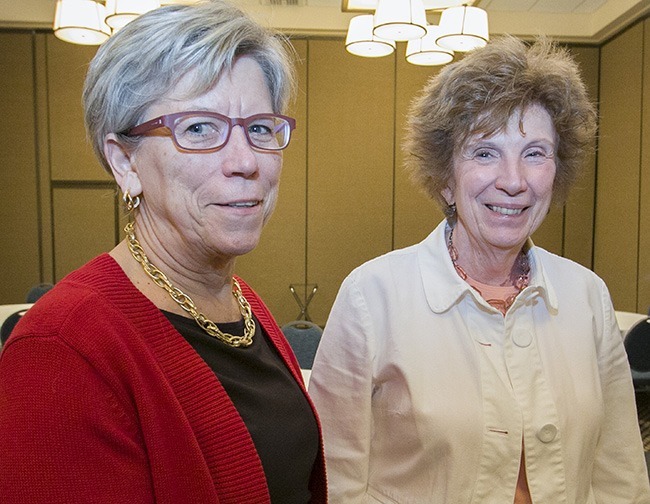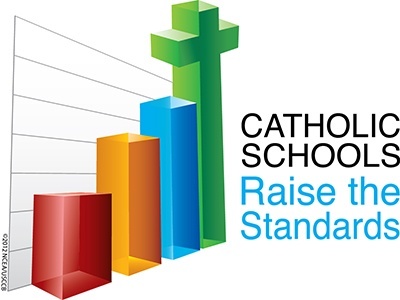By Ana Rodriguez Soto - The Archdiocese of Miami

Photographer: ANA RODRIGUEZ-SOTO | FC
Lorraine Ozar, right, director of the Center for Catholic School Effectiveness at Loyola University Chicago, and Patricia Weitzel-O'Neill, executive director of Boston College's Barbara and Patrick Roche Center for Catholic Education, visited Miami in January to talk about the National Standards and Benchmarks for Effective Catholic Elementary and Secondary Schools, which will become part of the accreditation process for the Archdiocese of Miami.
- Centered in the person of Jesus Christ
- Contributing to the evangelizing mission of the Church
- Distinguished by excellence
- Committed to educate the whole child
- Steeped in a Catholic worldview
- Sustained by Gospel witness
- Shaped by communion and community
- Accessible to all students
- Established by the expressed authority of the bishop
For example, standard 1 says: �An excellent Catholic school is guided and driven by a clearly communicated mission that embraces a Catholic identity rooted in Gospel values, centered on the Eucharist, and committed to faith formation, academic excellence and service.� The five benchmarks that accompany that standard are:
- that the mission statement includes the commitment to Catholic identity;
- that the mission statement is the foundation and normative reference for all planning
- that the school�s various constituencies (from staff and students to parents and alumni) regularly come together to clarify, review and renew the school�s mission statement
- that the mission statement is visible in public places and contained in official documents
- that all constituents know and understand the mission.
�This really is a landmark document,� said Lorraine Ozar, director of the Center for Catholic School Effectiveness at Loyola University Chicago, and one of the authors of the standards. �I think people are embracing them because there is in fact a great need.�
Ozar and fellow committee member Patricia Weitzel-O�Neill, executive director of Boston College�s Barbara and Patrick Roche Center for Catholic Education, visited Miami in January to talk about the standards with archdiocesan principals and teachers. The Archdiocese of Miami is incorporating the standards into its school accreditation process.
�It�s our framework to maximize every school�s potential,� said Kim Pryzbylski, archdiocesan superintendent of schools.
The National Standards and Benchmarks for Effective Catholic Elementary and Secondary Schools were developed by a national committee of Catholic educators that began meeting in February 2010. They are based on Church documents and conversations with Catholic school administrators as well as consultation with bishops. And they grew out of a need first identified by the people who teach and administer Catholic schools throughout the U.S.
�These did not come from on high,� said Weitzel-O�Neill. �They were not dictated by the Church to the schools. It came from a group of superintendents and Catholic school leaders. Everybody had a chance to give feedback. It came from the practitioners.�
She noted that these are �school effectiveness standards, not curriculum standards.�
Ozar called them �non-negotiable descriptions of what a really excellent Catholic school in this century should look like.� She added that the standards �come a step closer to identifying the �brand� of Catholic education.�
Granted, no such branding might have been needed in the 1950s and 1960s, when Catholic schools were operated almost exclusively by religious orders.
�There was a shared understanding of what a Catholic school was,� said Weitzel-O�Neill. �As we became more diversified, we became more separate.�
�The religious community provided sort of that glue and they had their religious charism,� said Ozar. Inside and outside the Church there also was a crystal-clear understanding that �this is the way everybody believed if you were a Catholic.�
�It�s a different Church,� said Weitzel -O�Neill.
�And a different world,� added Ozar.
Pryzbylski also noted that when teachers and administrators all lived in the same convent, they were able to compare notes every night, at the same time preserving a sense of community in the schools. But such sharing over the dinner table does not happen when staff and administrators are almost exclusively lay.
�Now we have to make time to continue the conversation. And the standards bring that to light. Our heritage is what the sisters did. And we have to continue that now with lay professional educators,� Pryzbylski said.
The standards dovetail nicely with the Common Core curriculum that has been adopted by 46 states for their public schools, including Florida. Like its predecessor, No Child Left Behind, Common Core is part of a national movement to hold schools and teachers accountable for the education they provide their students.

The motto for this year's Catholic Schools Week celebration, Jan. 27-Feb. 1, alluded to the National Standards and Benchmarks for Effective Catholic Elementary and Secondary Schools.
�It�s really all about improving and trying to be the best,� said Antoinette McNamara, principal of All Saints School in Sunrise. �You�re going to be evaluating yourself and then also our system as an archdiocese. � I like it because it�s giving you something specific to look at � and goals.�
That�s important because, as Ozar put it, �if you�re not in continuous improvement mode, then you�re moving backwards in today�s world.�

